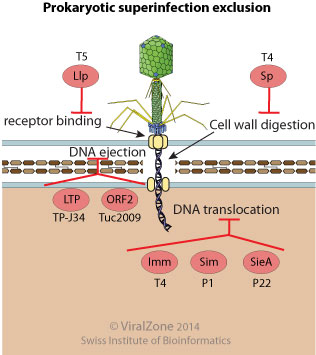Superinfection exclusion (kw:KW-1260)
Superinfection exclusion is a phenomenon in which a preexisting viral infection prevents a secondary infection with the same or a closely related virus. This phenotype is often poorly understood, and may reflect programmed virus superinfection or a kind of antiviral state of the infected cell.
Some bacterial viruses encode proteins to achieve superinfection exclusion. These viral proteins can interfere with DNA release into the host cytoplasm or modify the entry receptor. They can also act as inhibitors of viral peptidoglycan degradation enzymes thereby preventing entry of incoming phages  .
.

Many viruses can make superinfection exclusion, few examples are described below:
| Family | Genus | Virus | Superinfection exclusion protein | strategy | references |
| Baculoviridae | Alphabaculovirus | AcMNPV | undocumented | undocumented | 
|
| Closteroviridae | Closterovirus | Citrus tristeza virus | p33 | undocumented |  |
| Flaviridae | Hepacivirus | Hepatitis C | Undocumented | post entry | 
|
| Siphoviridae | Lambdalikevirus | Enterobacteria phage HK97 | gp15 | Undocumented | 
|
| Siphoviridae | T5likevirus | Enterobacteria phage T5 | Lipoprotein Llp | Blocks T5 entry receptor FhuA |

|
| Myoviridae | T4likevirus | Enterobacteria phage T4 | Immunity protein Imm Protein spackle Sp |
Blocks DNA translocation into host cytoplasm Inhibits the lysozyme activity |

|
| Siphoviridae | unclassified | Bacteriophage TP-J34 | Lipoprotein LTP | Blocks DNA ejection into host cytoplasm | 
|
| Siphoviridae | unclassified | Lactococcus phage Tuc2009 | ORF2 | Blocks DNA ejection into host cytoplasm |

|
| Podoviridae | P22likevirus | Enterobacteria phage P22 | SieA | Blocks DNA translocation into host cytoplasm | 
|
| Myoviridae | Punalikevirus | Enterobacteria phage P1 | Sim | Probably blocks DNA translocation into host cytoplasm |

|
Svetlana Y Folimonova
J. Virol. May 2012; 86: 5554-5561
Ines Beperet, Sarah L Irons, Oihane Simon, Linda A King, Trevor Williams, Robert D Possee, Miguel Lopez-Ferber, Primitivo Caballero
J. Virol. March 2014; 88: 3548-3556
Hofer B, Ruge M, Dreiseikelmann B
J Bacteriol. 1995 Jun;177(11):3080-6
Stephen McGrath, Gerald F Fitzgerald, Douwe van Sinderen
Mol. Microbiol. January 2002; 43: 509-520
Bebeacua C, Lorenzo Fajardo JC, Blangy S, Spinelli S, Bollmann S, Neve H, Cambillau C, Heller KJ
Mol Microbiol. 2013 Jul;89(1):152-65
Braun V, Killmann H, Herrmann C
J Bacteriol. 1994 Aug;176(15):4710-7
Lu MJ, Henning U
Trends Microbiol. 1994 Apr;2(4):137-9
Nichole Cumby, Aled M Edwards, Alan R Davidson, Karen L Maxwell
J. Bacteriol. September 2012; 194: 5012-5019
Brian Webster, Melanie Ott, Warner C Greene
J. Virol. December 2013; 87: 13354-13369
Labrie SJ, Samson JE, Moineau S
Nat Rev Microbiol. 2010 May;8(5):317-27
M Kliem, B Dreiseikelmann
Virology August 1989; 171: 350-355
Matching UniProtKB/Swiss-Prot entries
(all links/actions below point to uniprot.org website)3 entries grouped by strain
2 entries
Enterobacteria phage T4 (Bacteriophage T4) reference strain
1 entry
